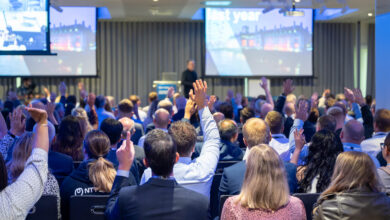How to Drive Innovation in Services Procurement

Businesses have always relied on third-party services to help them get things done. Today’s business environment makes procuring the right services at the right price from the right provider crucial for success. And yet, many organizations lack a mature approach to sourcing and managing services. This exposes them to greater risk and higher costs, and it leaves them unable to measure project outcomes effectively.
These are among the findings of the newly released Benchmarking Services Procurement: A Global Study, conducted by Art of Procurement and sponsored by SAP. In examining the current state of services procurement, the study seeks to answer two basic questions: Is procurement moving beyond the role of “a pass-through for services contracts”? And how are procurement teams using new approaches and technology to innovate services procurement?
The Challenges of Procuring Services
Whether it’s for IT consulting, marketing services, facilities management, or legal services, procuring services through a third party gives organizations access to personnel with advanced skills and expertise. It can also be cost-effective.
Business leaders have taken note, as highlighted in 2023 research from Ardent Partners. “On average, professional services spending comprises between 45% and 65% of an organization’s total non-employee spending,” Ardent reports.
However, acquiring these services requires a significant level of procurement sophistication. Many services are too complex to fit neatly into a catalog and sourcing them requires organizations to consider key questions, including:
- Are we buying labor or an outcome?
- What is the cost mechanism – daily rates, time and materials, fixed-fee?
- Can we balance risk with agility?
- How do we maintain our service provider relationship?
Procurement teams have the expertise to bring a higher level of maturity to professional services. They provide a strategic approach that streamlines everything from sourcing and contracting to invoicing and vendor management. But are businesses taking full advantage of their expertise?
Three Things the Study Tells Us
The Art of Procurement study reveals a lot about the state of professional services procurement. Here are a few of my thoughts – from a global perspective.
Many organizations aren’t benefiting from technology.
Fifty percent of respondents said they purchase services contracts via e-mail and phone, and 23% buy from the same procurement catalogs they use to buy goods. Only 27% use a technology platform designed for services procurement.
Choosing not to use services procurement technology creates compliance and governance challenges. It also limits buyers’ ability to get the best pricing. Moreover, e-mails and phone calls don’t provide a secure, centralized data trail, which is useful for demand planning and forecasting and for making strategic decisions about insourcing and outsourcing.
Too often, bidders seek fixed pricing. That inhibits innovation.
Seventy-nine percent of respondents said they use some form of fixed pricing to buy services. Although this allows them to know the price up front, it also presents challenges. For example, with fixed pricing, statements of work must be tightly written to detail exact project requirements. Otherwise, businesses could pay for more than they receive.
The Art of Procurement research also notes “a worrisome lack of risk and reward mechanisms in services procurement contracts.” It warns that disregarding these innovative mechanisms can jeopardize supplier relationships and stifle innovation. “Without clear incentives for success and mitigations for failure, procurement could unintentionally foster a transactional, short-term mindset in suppliers, leading to cut corners or a reluctance to invest in long-term innovation.”
Organizations prefer single project bids, which are less efficient.
In the survey, 39% of respondents said they set rates by project. Managing bids one by one forces businesses to go back to the market continuously – requiring more proposals, more negotiation, and more contracts.
But there’s also good news. The remaining 61% of respondents say they use either frameworks or preferred supplier panels to drive efficiency. A framework is a general agreement with pre-qualified suppliers, outlining terms and conditions under which specific goods or services will be procured. Panels are groups of pre-approved suppliers, selected for their ability to deliver specific services. These suppliers meet specific qualification criteria and have undergone a competitive selection process.
Overall, the Art of Procurement study paints a picture where procurement is not putting forth its expertise to help the business acquire and manage professional services. As such, it is conceding its strategic role to stakeholders and suppliers.
How Technology Can Help Turn the Tide
The Art of Procurement study advises procurement teams to “select and implement technology with breadth in mind, aiming to address as much services spend as possible rather than allowing pockets of sourcing activity to flow through non-standard platforms and processes.”
SAP Fieldglass Services Procurement is a broad technology application that can simplify how external services projects are initiated, engaged, managed, and completed. It can enable procurement teams to:
- Initiate service requests with competitive bidding, facilitating collaboration on bid criteria with colleagues, expedited approvals for authorized terms and budgets, and distribution of bids to services providers.
- Engage selected vendors through a negotiation process that follows a side-by-side evaluation of all responses, and then finalize an agreement.
- Manage global services engagements within a single, centralized system – securely onboarding workers, tracking deliverables, validating work, and generating invoices.
- Complete the project with automated offboarding, including terminating system access, retrieving assets, and giving performance feedback.
SAP Fieldglass has been named to the G2 list of Best Software Products for 2024, based on user reviews. It is also one of G2’s Best Mid-Market Products for 2024.
Procurement Must Lead the Way
Based on the findings of the Art of Procurement study, it’s clear that organizations need to adopt a more mature approach to services procurement. Procurement teams have the expertise to lead this transformation, although they must do more to assert themselves within the business. Technology can help accelerate this by enabling procurement to establish consistent, end-to-end processes for initiating, engaging, and managing external service projects.
Read the Art of Procurement report here.
Gordon Donovan is global vice president of Research, SAP Procurement, and External Workforce at SAP.



